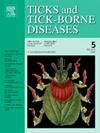Sympatric occurrence of Ixodes ricinus, Haemaphysalis concinna and Haemaphysalis inermis in a wild fauna reserve
IF 3.4
2区 医学
Q2 INFECTIOUS DISEASES
引用次数: 0
Abstract
Wildlife reserves represent confined ecosystems with a high concentration of non-native animal species. The Réserve Zoologique de la Haute Touche, a unique forested environment, houses approximately 50 species, primarily Artiodactyla and Perissodactyla. We conducted a comprehensive tick survey within the reserve in 2017, collecting ticks from vegetation by flagging (outside enclosures on 101 sampling points in May and September, inside 21 enclosures in May), by visual search outside enclosures in May, and directly on animals captured for routine veterinary interventions, over four consecutive years (2015–2018).
A total of 13,038 questing ticks, representing seven species, were collected via flagging outside and inside enclosures. Ixodes ricinus (88.9%), Haemaphysalis concinna (10.1 %), and Haemaphysalis inermis (1 %) were the dominant species, with all three parasitic life stages of these species found in May. The less common species were Ixodes acuminatus (2 nymphs), Ixodes frontalis (2 nymphs), Dermacentor reticulatus (3 adults), and Dermacentor marginatus (1 adult). Ixodes ricinus was ubiquitous throughout the reserve, outside and inside enclosures, at nearly all sampling sites (100/101 and 9/21 enclosures), followed by H. concinna (78/101 sites and 6/21 enclosures) and H. inermis (49/101 sites and 1/21 enclosures). Tick densities varied greatly with peak densities reaching 1221 I. ricinus nymphs per 100 m² and 46 I. ricinus adults per 100 m² in May. Haemaphysalis concinna densities reached 124 nymphs per 100 m². Visual searches for adult ticks on vegetation revealed statistically different proportions of these three species between different areas of the reserve, with H. inermis reaching 40.5 % of the collected adults in a specific area. Enclosures housing roe deer (Capreolus capreolus) and red deer (Cervus elaphus) exhibited the highest tick abundance on vegetation. Feeding ticks, including I. ricinus (n = 53), H. concinna (n = 26), and D. reticulatus (n = 1), were collected from 15 animals of six ruminant species.
This study represents the first documented sympatric occurrence of I. ricinus, H. concinna, and H. inermis in France, and the first description of Haemaphysalis species within a zoological reserve. The potential for pathogen transmission by these three generalist species and especially Haemaphysalis species (paucity of data) warrants further investigation.
野生动物保护区内蓖麻蜱、麻血蜱和残血蜱的同域分布
野生动物保护区是一种非本地动物物种高度集中的封闭生态系统。r serve Zoologique de la Haute Touche是一个独特的森林环境,拥有大约50个物种,主要是偶蹄动物和短蹄动物。2017年,我们在保护区内进行了全面的蜱虫调查,在连续四年(2015-2018)中,通过标记(5月和9月在101个围场外采样点,5月在21个围场内),5月在围场外视觉搜索,以及直接在常规兽医干预下捕获的动物身上收集蜱虫。通过在室外和室内进行标记,共收集了7个物种的13038只蜱虫。优势种为蓖麻硬蜱(88.9%)、粗血蜱(10.1%)和无血蜱(1%),3个寄生期均在5月份。较少见的种为尖革蜱(2只若虫)、额革蜱(2只若虫)、网状革蜱(3只成虫)和边缘革蜱(1只成虫)。在100/101和9/21个圈地中,蓖麻伊蚊在保护区内外均普遍存在,其次是麻伊蚊(78/101和6/21个圈地)和麻伊蚊(49/101和1/21个圈地)。蜱虫密度变化较大,5月最高密度为每100 m²1221只蓖麻螨蛹和每100 m²46只成虫。血蜱密度达到每100平方米124若虫。在植被上的目视搜索显示,在保护区不同区域,这三种蜱的比例有统计学差异,在特定区域,寄生蜂的比例达到40.5%。黄鹿(Capreolus Capreolus Capreolus)和马鹿(Cervus elaphus)围场对植被的蜱虫丰度最高。从6种反刍动物15只身上采集食性蜱,其中蓖麻蜱53只、粗腹蜱26只、网状蜱1只。这项研究首次记录了蓖麻蜱、麻毒蜱和寄生蜂在法国的同域分布,并首次描述了动物保护区内的血蜱物种。这三种多面手种,特别是血蜱种传播病原体的可能性(缺乏数据)值得进一步调查。
本文章由计算机程序翻译,如有差异,请以英文原文为准。
求助全文
约1分钟内获得全文
求助全文
来源期刊

Ticks and Tick-borne Diseases
INFECTIOUS DISEASES-MICROBIOLOGY
CiteScore
6.90
自引率
12.50%
发文量
185
审稿时长
6-12 weeks
期刊介绍:
Ticks and Tick-borne Diseases is an international, peer-reviewed scientific journal. It publishes original research papers, short communications, state-of-the-art mini-reviews, letters to the editor, clinical-case studies, announcements of pertinent international meetings, and editorials.
The journal covers a broad spectrum and brings together various disciplines, for example, zoology, microbiology, molecular biology, genetics, mathematical modelling, veterinary and human medicine. Multidisciplinary approaches and the use of conventional and novel methods/methodologies (in the field and in the laboratory) are crucial for deeper understanding of the natural processes and human behaviour/activities that result in human or animal diseases and in economic effects of ticks and tick-borne pathogens. Such understanding is essential for management of tick populations and tick-borne diseases in an effective and environmentally acceptable manner.
 求助内容:
求助内容: 应助结果提醒方式:
应助结果提醒方式:


